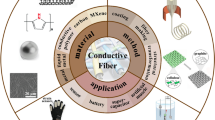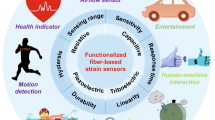The design and principle of operation of a multi-sensor converter of binary mechanical signals into electrical signals based on a partitioned fiber-optic digital-to-analog converter with parallel structure are considered. The digital-to-analog converter is made from a set of simple and fiber-optic digital-to-analog sections adaptable to streamlined production (three- and five-bit). The advantages of the optical layout of the proposed converter on metrological and energy characteristics, in comparison with unary multi-bit converters, are substantiated. It is shown that as a result of an increase in the number of digital-to-analog sections, it is possible to increase by a large factor the information capacity of the multi-sensor converter without tightening the requirements for its manufacturing design and component base. A mathematical model of the proposed converter has been developed that reflects the features of functioning under conditions of time-sequenced conversion of the input mechanical code vectors of the separate fiber-optic sections into electrical analogs, and generating a resultant output code vector. The developed mathematical model can be used at the design phase for converters of binary mechanical signals, in order to obtain extensive and deep information on the engineering prospects of the future product, without resorting to expensive physical experiment.



Similar content being viewed by others
References
Yu. V. Gulyaev, S. A. Nikitov, V. T. Potapov, and Yu. K. Chamorovskii, ”Fiber-optic technologies, devices, sensors, and systems,” FOTON-EXPRESS, No. 6 (46), 114–127 (2005).
V. B. Garmash, F. A. Egorov, L. N. Kolomiets, et al., “Capabilities, problems and prospects for fiber-optic measuring systems in modern instrumentation,” FOTON-EXPRESS, No. 6 (46), 128–140 (2005).
Yu. N. Makarov, D. I. Serebryakov, T. I. Murashkina, and O. S. Graevskii, “A multi-channel fiber-optic level indicator and the method of its manufacture,” Datch. Sist., No. 12 (127), 43–46 (2009).
G. I. Leonovich, S. A. Matyunin, and N. A. Livochkina, “A multi-sensory fiber-optic pressure converter,” Vestn. Samar. Aerokosm. Univ., No. 7 (31), 123–127 (2011).
S. A. Babin, S. K. Glushko, A. M. Tsyba, et al., “The concept of a multi-function coal mine safety system using fiberoptic technologies,” Vychisl. Tekhn., 18, Spec. Iss., 95–100 (2013).
V. M. Grechishnikov and O. V. Teryaeva, “Fiber-optic converters of onboard sensors of aircraft mechanization,” Izv. VUZ. Aviats. Tekhn., No. 3, 122–128 (2016).
V. M. Grechishnikov, G. I. Leonovich, A. S. Lukin, and N. A. Livochkina, “Multisensor fiber-optic converters of transport systems,” Izv. Samar. Nauch. Ts. RAN, Spec. Iss., Persp. Napravl. Razv. Transp. Sist., SNTs RAN, Samara (2007), pp. 95–99.
V. V. Shishkin, A. E. Churin, D. S. Kharenko, and I. S. Shelemba, “A monitoring system for the load-bearing structures of a football arena based on fiber optic sensors,” FOTON- EXPRESS, No. 6, 22–23 (2013).
G. Buimistryuk, “Fiber optic sensors for extreme conditions,” Contr. Eng. ROSSIYa, No. 3 (45), 34–40 (2013).
R. Hui and M. O’Sullivan, Fiber Optic Measurement Techniques, Academic Press, (2009), https//doi.org/https://doi.org/10.1016/B978-0-12-373865-3-da.X0001-8.
W. Li, J. Pang, X. Lu, and J. Liu, Photonic Sensors, 4, No. 2, 173–179 (2014), https://doi.org/https://doi.org/10.1007/s13320-014-0163-6.
Z. Luo, H. Wen, and H. Guo, Photonic Sensors, 4, No. 2, 168–172 (2014), https://doi.org/https://doi.org/10.1117/12.2031185.
I. I. Nuriev, “Sensor-based passive optical networks and key problems of application of fiber Bragg gratings in them,” Inzh. Vestn. Dona (online sci. journal), No. 2 (2016).
S. V. Varzhel’, Fiber Bragg Gratings, ITMO University, St. Peterrsburg (2015).
O. V. Teryaeva, Multi-Sensor Information Converters Based on Fiber-Optic DACs: Dissert. Cand. Techn. Sci., Samara University, Samara, (2017).
V. M. Grechishnikov and E. G. Makarov, “A mathematical model of the operation of a multisensor converter of binary mechanical signals to electrical signals based on a fiber-optic digital-to-analog converter,” Izmer. Tekh., No. 2, 20–26 (2020), https://doi.org/https://doi.org/10.32466/0368-1025it.2020-2-20-28.
V. M. Grechishnikov, O. V. Teryaeva, and V. V. Aref’ev, Patent No. 2661752 RF, Izobret. Polezn. Modeli, No. 20 (2018).
V. S. Gutnikov, Integrated Electronics in Measuring Devices, Energoatomizdat, Leningrad (1988).
V. G. Domrachev and B. S. Meiko, Digital Angle Converters: Principles of Construction, Accuracy Theory, Control Methods, Energoatomizdat, Moscow (1984).
V. M. Grechishnikov and N. E. Konyukov, Optoelectronic Digital Displacement Sensors with Integrated FOCLs, Energoatomizdat, Moscow (1992).
Author information
Authors and Affiliations
Corresponding author
Additional information
Translated from Izmeritel’naya Tekhnika, No. 9, pp. 15–23, September, 2020.
Rights and permissions
About this article
Cite this article
Grechishnikov, V.M., Komarov, E.G. Increasing the Information Capacity of a Fiber-Optic Multi-Sensor Converter of Binary Mechanical Signals Into Electrical Signals. Meas Tech 63, 690–699 (2020). https://doi.org/10.1007/s11018-021-01841-4
Received:
Accepted:
Published:
Issue Date:
DOI: https://doi.org/10.1007/s11018-021-01841-4




